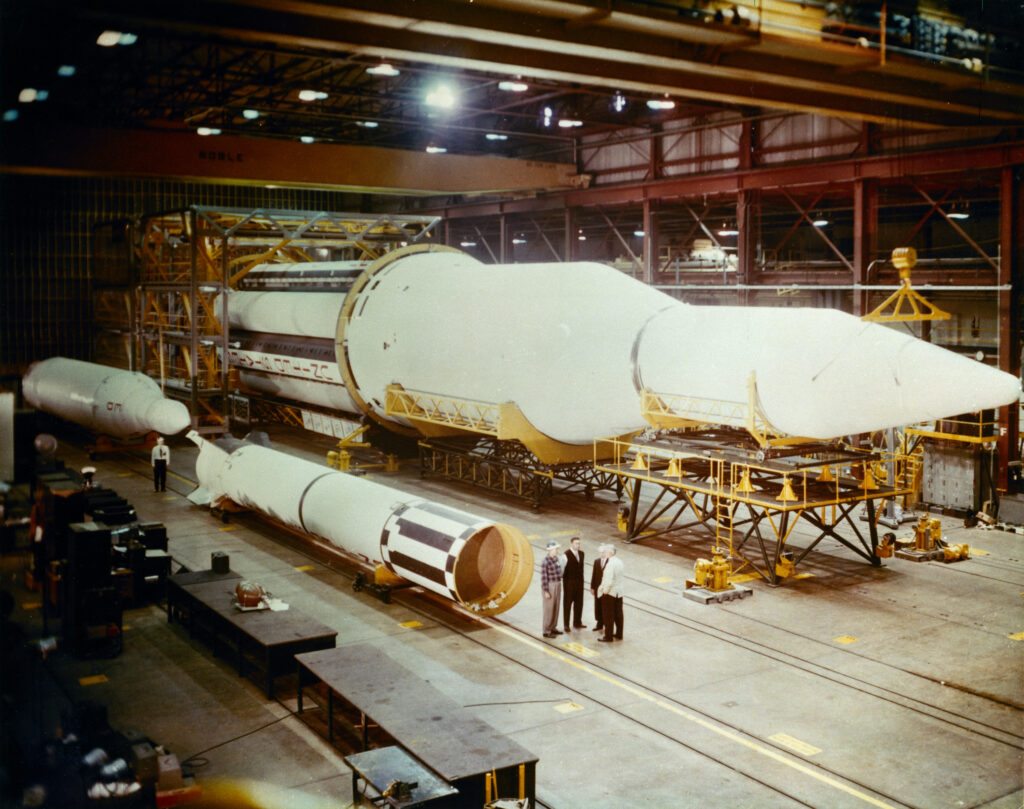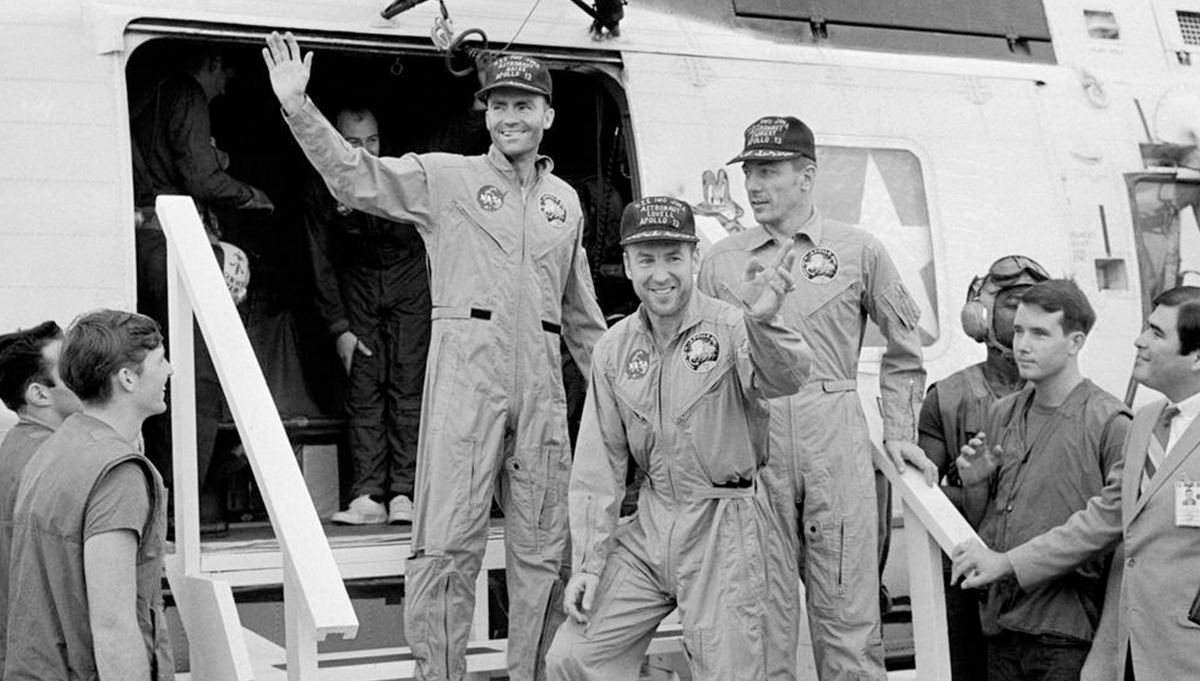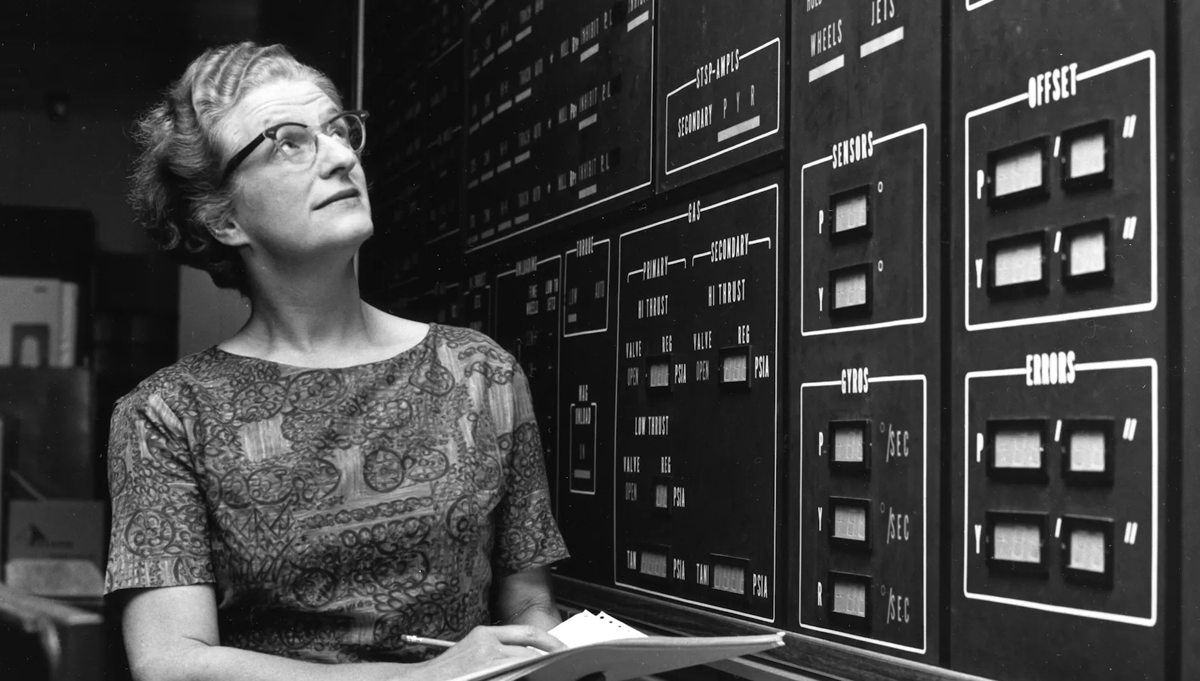
In January 1961, engineers at NASA’s Marshall Space Flight Center prepared the massive first stage of the Saturn I rocket for checkout. The booster was designed with eight clustered H-1 engines capable of producing as much as 1.5 million pounds of thrust. Credit: NASA
Saturn I-A was the bold first step in a giant technological leap.
When it was stacked for launch at Cape Canaveral Air Force Station in October 1961, the personnel there had never seen anything quite like it, a massive three-stage rocket taller than a 16-story building and weighing 460 tons. At 162 feet tall, it was nearly double the size of the Mercury-Redstone rockets that had launched Alan Shepard, Jr. and Virgil I. “Gus” Grissom on suborbital flights earlier that year.
The components of NASA’s Saturn I-A began arriving at Cape Canaveral by barge in the spring of 1961, several weeks before President John F. Kennedy would propose to the U.S. Congress that the nation commit itself to the goal of “landing a man on the Moon and returning him safely to the Earth” by the end of the decade.

Saturn-I first stage (S-1 stage) being transported to the test stand for a static test firing at the Marshall Space Flight Center. Credit: NASA
Development of the Saturn rocket system, which would eventually take the first humans to the Moon and back, began in the late 1950s within the U.S. Department of Defense at the Army Ballistic Missile Agency (ABMA). It was the first large rocket NASA would use that wasn’t adapted from a weapons system. From the beginning, Saturn had been conceived as a powerful launch vehicle for satellites and other heavy payloads at the dawn of the space age.
The Saturn I-A was the beginning of a staggering advance in aerospace technology. “It was as if the Wright Brothers had gone from building their original Wright Flyer in 1903 to developing a supersonic Concorde in 1913. Unimaginable; yet in 10 short years the builders of Saturn progressed from the small, single-engine rockets like Redstone to the giant vehicle with clustered engines that put man on the moon,” wrote William R. Lucas, in the forward to the book Stages to Saturn. Lucas was the Director of NASA’s Marshall Space Flight Center (MSFC) from 1974 to 1986.
“Our Earth-to-orbit weight-lifting capability grew in that decade by 10 thousand times. Saturn was an engineering masterpiece. The ultimate Saturn, taller than the Statue of Liberty, had a takeoff weight that exceeded that of 25 fully loaded jet airliners, and produced as much power as 85 Hoover Dams,” wrote Lucas.
Work on the Saturn I-A began in 1957 when a team led by aerospace engineer Dr. Wernher von Braun, working at ABMA, began exploring the concept of a rocket with a then unheard-of 1.5 million pounds of thrust. The team was transferred to NASA’s MSFC, where von Braun became the first director in 1960, a position he would hold for a decade. The agency took over the development of Saturn, which became a key component of the Apollo Program.

The flight configuration of the giant three-stage Saturn C-1 rocket (later called Saturn I Block I) is seen in the Fabrication and Assembly Engineering Division at MSFC. Dwarfed by the 180-foot C-1 are a Juno II rocket (left rear) and a Mercury-Redstone rocket (front foreground). Credit: NASA
Significant engineering challenges included developing a system to effectively use eight Rocketdyne H-1 engines, tightly grouped on the rocket’s first stage booster, which burned liquid oxygen and a highly refined form of kerosene, known as RP-1. The engines were clustered into two rings, with the engines in the inner ring fixed and engines in the outer ring gimbaled. Controlling heat at the base was a key issue because the rocket’s exhaust could interact with shock waves behind the vehicle, creating areas of stagnant air and turbulent mixing. Engineers were concerned these trapped pockets of air could heat to dangerously high temperatures, and the fuel-rich exhaust from the turbopumps could mix with these hot spots, potentially igniting them.
By positioning the inner engines as close together as possible, engineers minimized stagnant and turbulent zones. An engine skirt diminished high-speed airflow across the base, and a heavy firewall protected the turbopumps and fuel lines from the high-temperature gases.
The Saturn booster stage borrowed technology from earlier rockets, using a cluster of eight 70-inch-diameter tanks like those in the Redstone rockets that launched the first missions of Project Mercury, surrounding a 105-inch-diameter liquid oxygen tank like that used in the PGM-19 Jupiter ballistic missile. This arrangement enabled NASA to use tooling already in place with contractors to speed the Saturn I’s development.
On October 27, 1961, 63 years ago this month, NASA launched Saturn I-A. Mission control descended into whoops and laughter as the white rocket lifted into the bright blue sky and thick white clouds over Florida’s space coast.
“Go, man, go!” someone exclaimed.
Saturn I-A launched with two inert upper stages, filled with water to simulate fuel loading. The booster stage was detuned for the first launch and produced 1.3 million pounds of thrust, enough to reach of speed of 3,600 statute miles per hour during the 8-minute flight, carrying the spacecraft 185 nautical miles downrange. The flight was a successful first test of Saturn’s flight dynamics and the reliability of the booster stage’s clustered engine configuration.
“One of the most remarkable things about the Saturn program was its success rate,” Lucas wrote. “An early press release openly stated that because of the complexity of the system and the tremendous advancement in technology required, program officials fully expected half of the 10 Saturn Is launched to fail. None did.”
In addition to the 10 Saturn Is, NASA would launch 9 Saturn IBs, which carried astronauts into low-Earth orbit, and 13 Saturn Vs, the largest and most powerful configuration, between 1961 and 1973. These increasingly complex spaceflights culminated with nine successful trips to the Moon and six Moon landings.
To learn more about Saturn I-A, the Saturn program and Apollo, visit APPEL Knowledge Service’s Apollo Era Resources page.










